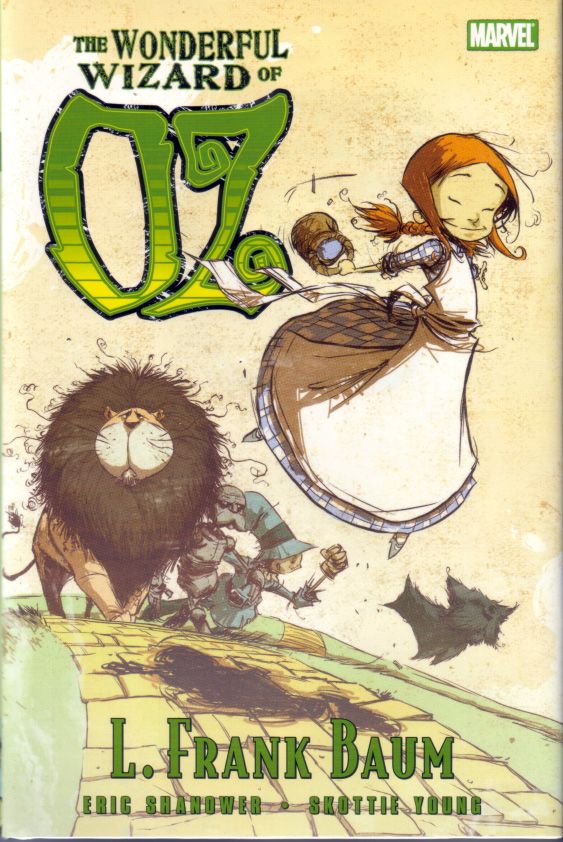I'm sick of "The Wizard of Oz." I saw the movie too many times as a kid, and its public domain nature has lead to a flurry of "Oz" titles in the back of the "Previews" catalog over the years, particularly in the last five. But if you clear out all the dross and the cheap cash-ins, what you can arrive at it something inspired and beautiful. That's where the Marvel-published "The Wonderful Wizard of Oz" comes in.
Done as part of Marvel's library-aimed adaptations of classic literature, Eric Shanower's script faithfully follows L. Frank Baum's original "Oz" novel with Skottie Young's scene-stealing visuals, so beautifully designed and expertly carried out that you'll wonder why more artists don't care so much about their work to go this far with it. Maybe it's time constraints. Maybe it's the nature of the beast. ("Spider-Man doesn't need a redesign every six months.") Man oh man, what I wouldn't give for a comic industry filled with titles like this one, each with a unique look. Young's characters are immediately identifiable from just their silhouette. If you saw them on a model sheet in turnaround, you'd still get a good idea what they're about. Everything is that well designed, right down to the architecture of Emerald City and the trees in the woods surrounding.
The coloring by Jean-Francois Beaulieu adds textures and tones to the pages like nothing we see in the usual Marvel or DC fare. There's even color added in the panel gutters to make the pages look slightly yellowed, and not bright white, which would distract from the art.
Jeff Eckleberry's lettering is subtly imperfect. The lines used on caption boxes waver a little bit, and no word balloon is a perfect circle, often having a flat side or two. It helps with the standard computer lettering problem of technically perfect lettering looking too sterile. It's forced imperfection to create something more organic out of something so technical.
Shanower is an "Oz" expert, having done his own series of adaptations in comics form a decade ago. Here, he hews closely to the original book, even using the original dialogue and narration where possible. It's not as slavish as Dynamite's "Dracula" work, though it still makes for a very different feel to the story from the movie, although the nature of the original story does lead to some repetition and monotony. "Oz" is a collection of little events, in which often nothing changes and the stakes don't raise too high. Each character openly expresses their story goal before being given what they want or, more often, being led into another adventure on the way down that literal yellow brick road. Again and again and again.
This is almost a collection best read in tiny chunks, like the Twitter of graphic novels. Segments are relatively short and self-contained, while the overall story is easy to pick up on at any point. Don't worry if your favorite character has just disappeared or been stranded or died; a random new character will show up in the next scene who will just happen to have the power to save him!
It's not a subtle story, either. Even having not seen the movie, the most simple of readers would have to see the end coming a mile away. How else to explain how all the best plans for survival coming from the character who wants a brain? Or the bravest moments in facing down foes coming from the character who wants courage? This isn't Shanower's fault, of course. It's the original text. "Oz" is a serialized kids book, but it overcomes those quirks in storytelling style with its charms, its memorable characters, and its imaginative landscape.
The mini-series completed in 2009, and a slightly-oversized hardcover collection of the eight issues is available today. It's a beautiful collection, too, with solid paper stock and plenty of sketchbook material in the back lightly annotated by Shanower to describe the evolution of the development of the series. There's also a cover gallery that gives each cover a full glorious page, not all jammed together on top of each other.
The interesting thing they did with the collected edition, though, is that they removed the chapter breaks. It's now one long book, not a series of issues packaged together. You can't tell where one issue ends and the next begins anymore, unless you want to count pages. It gives the book more of a novel's feel, where the story just carries through from start to finish, if you're in the mood to read it that way. It's a big help, of course, that the original issues didn't go overboard in recapping "the story so far" in the midst of the story. Besides, like I said previously, there's plenty of repetition in the original material to remind readers of what's going on.
"The Wonderful Wizard of Oz" beat a lot of my preconceptions to become one of my favorite comics of 2009. You can thank Shanower's faithful storytelling and bits of art direction, along with Skottie Young's career-best artwork for that. The world of comics needs more books like this one, and I'm thrilled that a second mini-series is being published right now. Perhaps we'll return to talk about that hardcover collection at this time next year.

